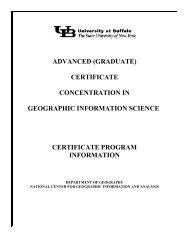Local Government GIS Demonstration Grant - NCGIA Buffalo
Local Government GIS Demonstration Grant - NCGIA Buffalo
Local Government GIS Demonstration Grant - NCGIA Buffalo
You also want an ePaper? Increase the reach of your titles
YUMPU automatically turns print PDFs into web optimized ePapers that Google loves.
Needs Assessment 41<br />
8 CONDUCTING INTERVIEWS<br />
Individual interviews are the most effective way of finding out from users their potential <strong>GIS</strong><br />
applications. Before starting interviews, a briefing session for all potential users should be held.<br />
During this meeting, the interviewers should describe the entire needs assessment procedure to all<br />
participants. The main activities will be:<br />
• Conduct "start-up" seminar or workshop<br />
• Interview each potential user<br />
• Prepare documentation (forms) for each application, etc<br />
• Review each application description with the user<br />
• Obtain user approval of and sign-off for each application description<br />
An introductory seminar or workshop with all potential users in attendance is useful to prepare the<br />
way for user interviews. At the beginning of a project, many users may not have much knowledge<br />
about <strong>GIS</strong> or how it might help them. Also, the interview team may be from outside the<br />
organization and may not be very familiar with the structure of the particular local government.<br />
The start-up seminar should address the following topics:<br />
• Definitions:<br />
What is a <strong>GIS</strong>?<br />
How is a <strong>GIS</strong> used by local government? (Typical applications)<br />
• Interview procedure to be followed:<br />
What the interviewee will do?<br />
What is expected from the interviewee?<br />
Who approves the application descriptions?<br />
How the information from the application descriptions will be used?<br />
• Group discussion: It is often useful to have the group identify an initial set of <strong>GIS</strong><br />
applications as candidates for further documentation. The discussion of possible<br />
applications between interviewers and users will start to reveal what is suitable for a<br />
<strong>GIS</strong> application. One or more applications can be described in the process by the group<br />
so everyone sees how the process will work.<br />
It is preferable to interview users individually rather than in groups. This provides a better<br />
opportunity to explore the ideas of each person and also prevents other individuals from<br />
dominating any particular meeting. Group meetings easily lose focus on specific <strong>GIS</strong> applications<br />
and therefore do not provide the detailed information needed to adequately describe the <strong>GIS</strong><br />
applications.<br />
Conducting an interview is not an easy task. Some potential users may have a good grasp of <strong>GIS</strong><br />
and how they might use one. However, often potential users do not have complete knowledge of<br />
the capabilities of a <strong>GIS</strong> and therefore may not be able to readily identify <strong>GIS</strong> applications. In these<br />
cases, the interviewer (<strong>GIS</strong> analyst) needs to help the user explore his/her job activities and<br />
responsibilities to identify <strong>GIS</strong> opportunities. The <strong>GIS</strong> analyst should usually begin an interview<br />
with a review of the procedure, then ask the user to identify and describe potential applications.<br />
When specific <strong>GIS</strong> applications cannot be easily identified, it is helpful if potential users describe,<br />
in general, his/her job functions and responsibilities and the role their department plays in the<br />
whole organization. From this discussion, the <strong>GIS</strong> analyst can usually identify potential <strong>GIS</strong><br />
applications and then explore these for possible inclusion in the needs assessment.




